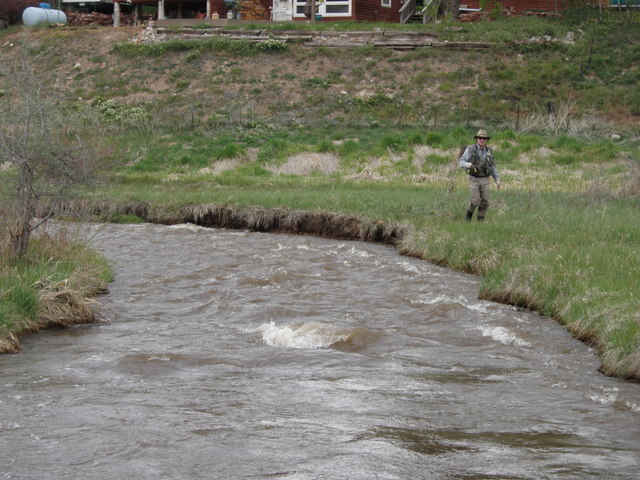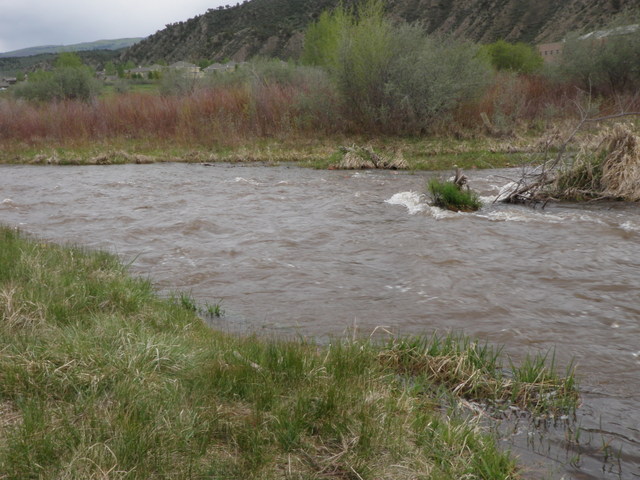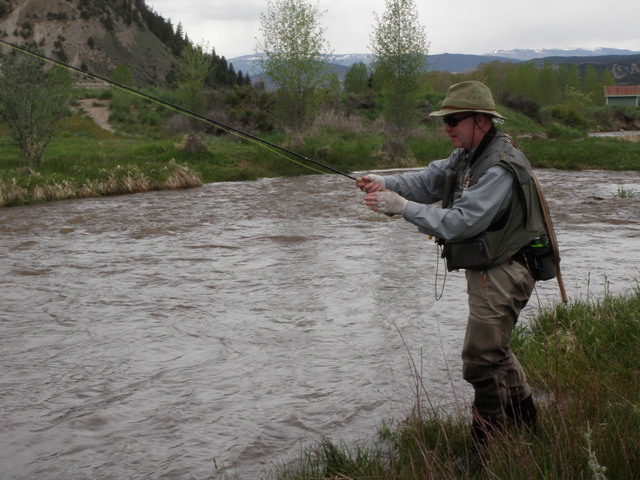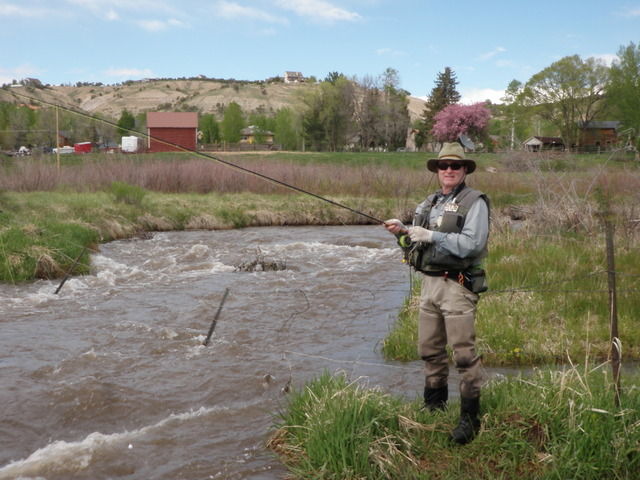Time: 2:00PM – 4:30PM
Location: Sylvan Lake Road to the beginning of the private water.
Fish Landed: 0
Brush Creek 05/24/2014 Photo Album
With snow melt still on the upswing on Colorado rivers and streams, would it be possible to catch fish in moving water, or should I be turning my attention to stillwater or travel to other locations such as Wisconsin or Pennsylvania where mountain snow melt is not a factor? My friend Dave Gaboury swears that it is possible to catch trout under the less than favorable conditions of high dirty water.
Beth and Dave live in Olathe, KS most of the time, but they also own a second home in Eagle, CO. They graciously invited Jane and I to join them and two other mutual friends for the Memorial Day Weekend. We quickly accepted, but I expected to mostly relax, eat, play games and undertake bike rides to get exercise. When I spoke to Dave G., however, he stressed that I should bring my fishing gear as we would do some fishing. I was skeptical, but he had done this before, and he was quite adamant that we would catch fish.
Jane and I departed Denver at 9:30AM on Saturday and arrived at Eagle, CO by noon. We made delicious sandwiches in the Gaboury kitchen, and then Dave G. asked if I was ready to fish. The sky was quite cloudy and overcast, but the clouds were high and didn’t suggest an immediate threat of rain. We put on our waders and configured our rods, and Jane drove us to our starting point where Brush Creek flows under Sylvan Lake Road at the northern end of Eagle Ranch. The creek was rushing rapidly toward the Eagle River and was the color of weak chocolate milk and came within 6-12 inches of the top of the bank in most places.
I was quite intimidated with these conditions, and I must admit that I had minimal confidence that either of us would hook, let alone land a fish. We began the ritual of playing hopscotch and fished our way along the right west bank. Every other time I fished Brush Creek, I could easily wade from one side to the other, but on Saturday we were locked to one side as it was too dangerous to cross. Dave G. suggested using two worm flies; an annelid style with red ribbing wrapped around the hook and bend and a classic red San Juan worm. I accepted his advice and tied one of each type of worm to my line beneath a thingamabobber and split shot.
It didn’t take long before Dave G. miraculously landed a small brown, but I continued hopping by him, and I didn’t experience any success. In fact within the first half hour I got snagged to the bottom twice and broke off both flies and the split shot. Dave G. suggested that I use 4X tippet to prevent frequent break offs, but I only had 3X, so I tied that on to my leader using a surgeon’s knot. Unfortunately I only had two red San Juan worms in my arsenal, so once I broke off the second one, I changed to a chocolate brown worm. When I stripped it in, I noticed that there was very little contrast in the brown murky water.
Meanwhile Dave G. continued to add to his fish count while my confidence slid to new depths. I decided I needed more contrast so I clipped off the brown San Juan worm and replaced it with a black woolly worm. This fly was at least 20 years old as I tied a few in Pennsylvania when I first began fly tying. Finally in a narrow relatively still area between the bank and the raging current I experienced a momentary hook up. I was attached to the fish long enough to lift its nose out of the water, but I could not determine which fly it took.
Because of the high water we were covering the stream quite rapidly as we continued to take turns in the fishable water, and there were large gaps in between. Finally I moved above Dave G. to a spot where he was confident I would catch a nice fish as he had hooked up with a brown in excess of 15 inches in this location previously. Much to my surprise as I lifted the line next to an exposed stick to make sure I wasn’t snagged, I felt some weight and set the hook. Immediately a nice fish began to thrash and fight to free itself. As the trout fought back and forth in the area between the heavy current and the bank, I enjoyed several views of it, and it surely was a fine brown in the fifteen inch range. Finally I felt I had tired it out enough to bring it to the bank in order to net, so I applied side pressure to keep its nose above the water and bring it across the current to where I was standing. Unfortunately the brown used its remaining energy to twist its head, and the hook came free. Not only did I fail to land a nice brown, but now I also didn’t know which fly enticed the finned foe.
Judging from the way the fish was fighting, I guessed that it was on the woolly worm. Since the woolly worm was an antique fly, I was concerned that the hook was too dull, so I clipped it off and replaced it with an orange and black woolly bugger. Unfortunately by now we were near our end point, the barbed wire fence that demarcated the beginning of the private water, so I only tested the orange and black woolly bugger for a short amount of time. When we reached the private water we both reeled up our lines and returned to the Gaboury house for snacks and cocktails.
Dave G. did indeed prove that he could catch fish in the high muddy conditions characterized by runoff. I also managed to connect with two fish, but was not fortunate enough to bring them to my net. I did, however, now believe that it was possible to catch fish under adverse runoff conditions.




